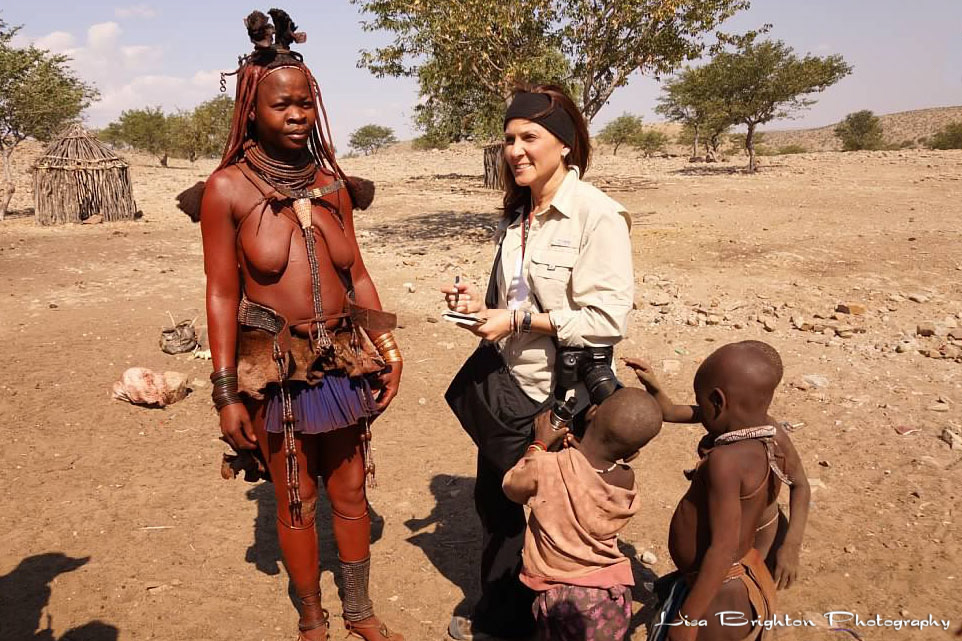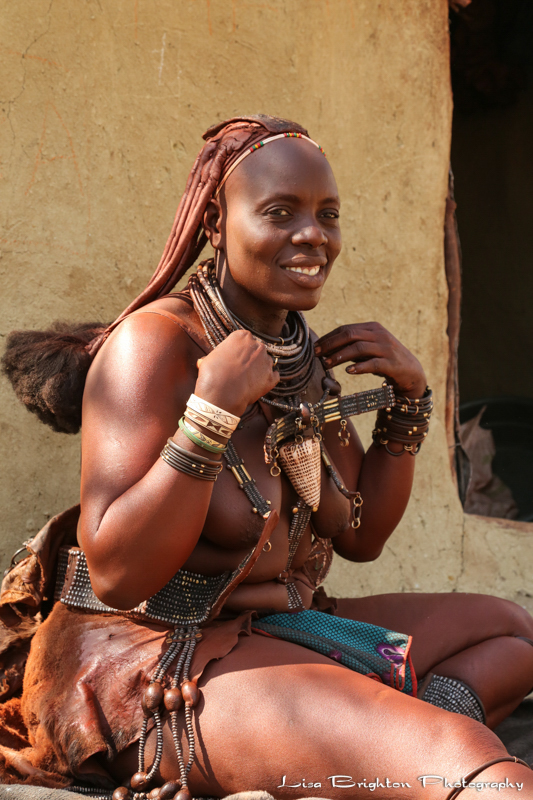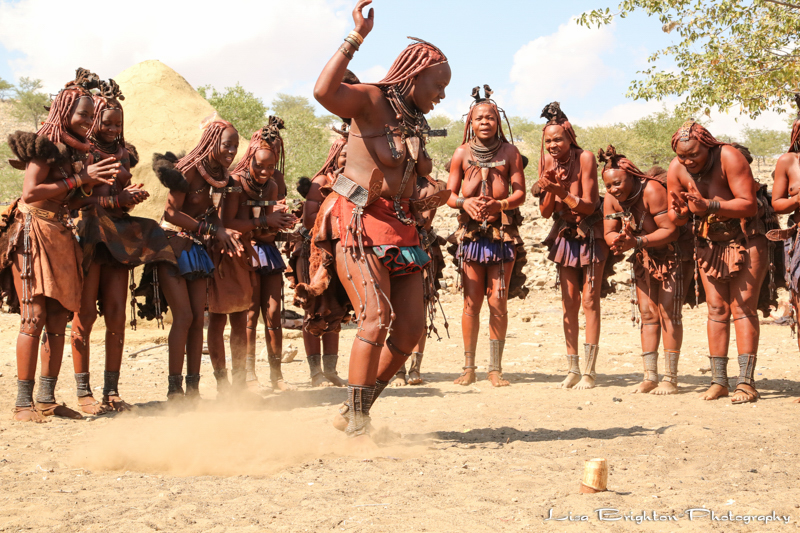4. Beautiful Eyes
 “Her name is Huyguriva,” Nestor, my interpreter says, “but her nickname is Chicken.” “Please tell her that it’s a pleasure to meet her, that my name is Lisa, and I’m from America.” I listen as Nestor translates my message. I don’t know the woman, but I’ve imagined meeting her ever since I saw images of the Himba Tribe in the pages of National Geographic as a young girl. Even then, I was curious about the Namibian women with ochre-colored skin, and I wondered what their lives were like here in Africa. Today I have the privilege of meeting her and visiting her village. My mind is racing with a thousand questions I’d like to ask her. As Nestor tells her my name, she looks at me with an intense gaze. Her powerful presence and strength is undeniable. I draw upon all my strength and conceal my nervousness as I interview her for my blog. I try not to get preoccupied with my own emotions, and through Nestor, I ask her to tell me about herself. I listen as she responds and Nestor interprets, “She is married and has two children.” “And at what age do most women marry?” She says, “Fourteen or fifteen is a good age for marriage.” “How does she spend her time as a wife and mother?” “With my duties,” she says. “I look after the cattle.
“Her name is Huyguriva,” Nestor, my interpreter says, “but her nickname is Chicken.” “Please tell her that it’s a pleasure to meet her, that my name is Lisa, and I’m from America.” I listen as Nestor translates my message. I don’t know the woman, but I’ve imagined meeting her ever since I saw images of the Himba Tribe in the pages of National Geographic as a young girl. Even then, I was curious about the Namibian women with ochre-colored skin, and I wondered what their lives were like here in Africa. Today I have the privilege of meeting her and visiting her village. My mind is racing with a thousand questions I’d like to ask her. As Nestor tells her my name, she looks at me with an intense gaze. Her powerful presence and strength is undeniable. I draw upon all my strength and conceal my nervousness as I interview her for my blog. I try not to get preoccupied with my own emotions, and through Nestor, I ask her to tell me about herself. I listen as she responds and Nestor interprets, “She is married and has two children.” “And at what age do most women marry?” She says, “Fourteen or fifteen is a good age for marriage.” “How does she spend her time as a wife and mother?” “With my duties,” she says. “I look after the cattle.  I herd them and milk them. I collect the water. I keep my house fit.” I take notes as Nestor speaks, not wanting to omit any details as she continues. “I collect grass seeds and pound them to make porridge. We eat this at sunrise and sunset.” Another tribal woman and some young boys walk up and join us. While the boys tug on my camera and water bottle, I continue talking to Huyguriva. “I’ve seen many women here in your village today, and they all have beautiful jewelry and adornments layered on their bodies. I know that the headdresses and jewelry signify social status, but at what age do you start to decorate your body like this? And how often do you apply the crushed stone and animal fat mixture to your skin?” “We start wearing metal upon maturity and apply the mixture each morning.” “And I see many children in your village. What do you do for medical care and child birth?” She responds, “We use tree leaves, powders and roots for medicine. Two women in the village help with child birth.” “No doctor?” “No.” She looks at me like she wants to say something more, but she doesn’t. Curious, I tell Nestor, “Please ask her if there is anything else she would like to say to me.” Nestor tells her what I said and she asks, “What do women in America do after they’ve had a baby to reduce their belly?” I smile to myself, surprised by the question. “Diet… exercise… and some women use creams on their skin if they have stretch marks.” As Nestor interprets, she puts her hand on her belly and gently touches some scars. “Are you married?” she asks. “No, I’m not.” “Do you have children.” “No.” “Why not?” I’m about to answer her question when the other woman who was observing says something to Huygyriva. “What did she say to her?” I ask Nestor. “She said that maybe you don’t want to be married.” I’m surprised by this comment, and then I see the look in her eyes. “Nestor, please ask her if she is married?” She replies, “I was married and my husband died. I have three children to raise by myself. It is a lot of work.” She sighs. “If I remarry, I will have to have more children. I will not remarry.” She seems sad. As a single woman, I feel compassion for this single woman who is raising three children alone — just as many women do all over the world. There is a pause in our conversation, and then she adds something. Nestor looks at me and flashes a small smile. “What did she say?” “She said that you have beautiful eyes.” I feel them welling with tears. “Please tell her that I said okoo hepa (thank you) and that she has beautiful eyes too. They are both beautiful women.” As Nestor relays what I said, I look at both of the women standing in front of me. Their sense of self is evident. They know who they are. Moments later, I watch them stand in a half circle, chanting and expressively moving their bodies to a rhythmic beat. I’m moved by their passion, sensuality and womanliness.
I herd them and milk them. I collect the water. I keep my house fit.” I take notes as Nestor speaks, not wanting to omit any details as she continues. “I collect grass seeds and pound them to make porridge. We eat this at sunrise and sunset.” Another tribal woman and some young boys walk up and join us. While the boys tug on my camera and water bottle, I continue talking to Huyguriva. “I’ve seen many women here in your village today, and they all have beautiful jewelry and adornments layered on their bodies. I know that the headdresses and jewelry signify social status, but at what age do you start to decorate your body like this? And how often do you apply the crushed stone and animal fat mixture to your skin?” “We start wearing metal upon maturity and apply the mixture each morning.” “And I see many children in your village. What do you do for medical care and child birth?” She responds, “We use tree leaves, powders and roots for medicine. Two women in the village help with child birth.” “No doctor?” “No.” She looks at me like she wants to say something more, but she doesn’t. Curious, I tell Nestor, “Please ask her if there is anything else she would like to say to me.” Nestor tells her what I said and she asks, “What do women in America do after they’ve had a baby to reduce their belly?” I smile to myself, surprised by the question. “Diet… exercise… and some women use creams on their skin if they have stretch marks.” As Nestor interprets, she puts her hand on her belly and gently touches some scars. “Are you married?” she asks. “No, I’m not.” “Do you have children.” “No.” “Why not?” I’m about to answer her question when the other woman who was observing says something to Huygyriva. “What did she say to her?” I ask Nestor. “She said that maybe you don’t want to be married.” I’m surprised by this comment, and then I see the look in her eyes. “Nestor, please ask her if she is married?” She replies, “I was married and my husband died. I have three children to raise by myself. It is a lot of work.” She sighs. “If I remarry, I will have to have more children. I will not remarry.” She seems sad. As a single woman, I feel compassion for this single woman who is raising three children alone — just as many women do all over the world. There is a pause in our conversation, and then she adds something. Nestor looks at me and flashes a small smile. “What did she say?” “She said that you have beautiful eyes.” I feel them welling with tears. “Please tell her that I said okoo hepa (thank you) and that she has beautiful eyes too. They are both beautiful women.” As Nestor relays what I said, I look at both of the women standing in front of me. Their sense of self is evident. They know who they are. Moments later, I watch them stand in a half circle, chanting and expressively moving their bodies to a rhythmic beat. I’m moved by their passion, sensuality and womanliness.
